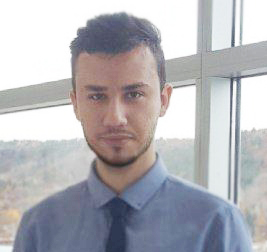
An abstract by Michigan Tech Ph.D. student Alireza Asadbeygi, biomedical engineering, has been selected as a finalist in the ASME-BED/SB3C Student Paper Competition. The conference takes place from June 20 to 23, 2022, in Chesapeake Bay, Maryland.
Asadbeygi’s paper is titled, “”Predicting Hemodynamic Indices in Coronary Artery Aneurysms Using Response Surface Method: An Application in Kawasaki Disease.” The research lies at the intersection of computational modeling, machine learning, and cardiovascular engineering. The results of the study will soon be published as a journal paper. Read the paper abstract below.
Asadbeygi is advised by Hoda Hatoum, assistant professor in the Biomedical Engineering department. Hatoum is a member of the Institute of Computing and Cybersystems’s Center (ICC) for Biocomputing and Digital Health (BDH). The ICC has provided Asadbeygi with a travel grant of $500 for conference travel and fees.
Asadbeygi’s research Interests include cardiovascular engineering, computational medicine, biomedical product development, and optimal design.
The Summer Biomechanics, Bioengineering, & Biotransport Conference (SB3C) is organized in conjunction with the Bioengineering Division (BED) of the American Society of Mechanical Engineers (ASME).
Paper Abstract:
Coronary artery aneurysms (CAA) describe local dilatations of the coronary artery that exceed 1.5 the neighboring artery diameter. The prevalence of CAA ranges from 0.3 to 5%. The pathogenesis of CAA is not well understood however, several factors come into play such as certain vasculitic and connective tissue diseases such as the Kawasaki disease (KD) . CAAs are mostly not accompanied by symptoms and their finding is usually incidental.
Literature has shown that the blood flow stagnation and sluggish flow are correlated with thrombosis and atherosclerosis. The goal of this study was to investigate the effect of CAA shape indices on local hemodynamics using the response surface method (RSM) through considering KD applications at rest (normal conditions) and during exercise. CFD was performed on idealized controlled geometries where different aspect ratios were considered. Regression models of time averaged wall shear stress (TAWSS), oscillatory shear index (OSI), and relative residence time (RRT) were developed. These models can be used as valuable tools to obtain a real-time assessment of CAA local hemodynamics and resulting risk stratification based on fusiform aneurysm shape indices.
In this study, a parametric CFD quantification of CAA was performed, and regression models of 2 hemodynamic metrics under normal at rest conditions and under exercise conditions were developed using the response surface method. The results show that TAWSS generally increased under exercise conditions regardless of the geometry. It is observed that the small aneurysms (low Dmax/Dneck) experience very high RRT values in elevated heart rates, which is neglected as a risk case in Z-score criteria. Our results indicate that the length of the aneurysm has significant effect on the altered hemodynamics; in the aneurysms having the same diameter, the one with shorter length is more prone to thrombus formation. These findings highlight the importance of computational tools to achieve a general understanding of the hemodynamics in CAA.